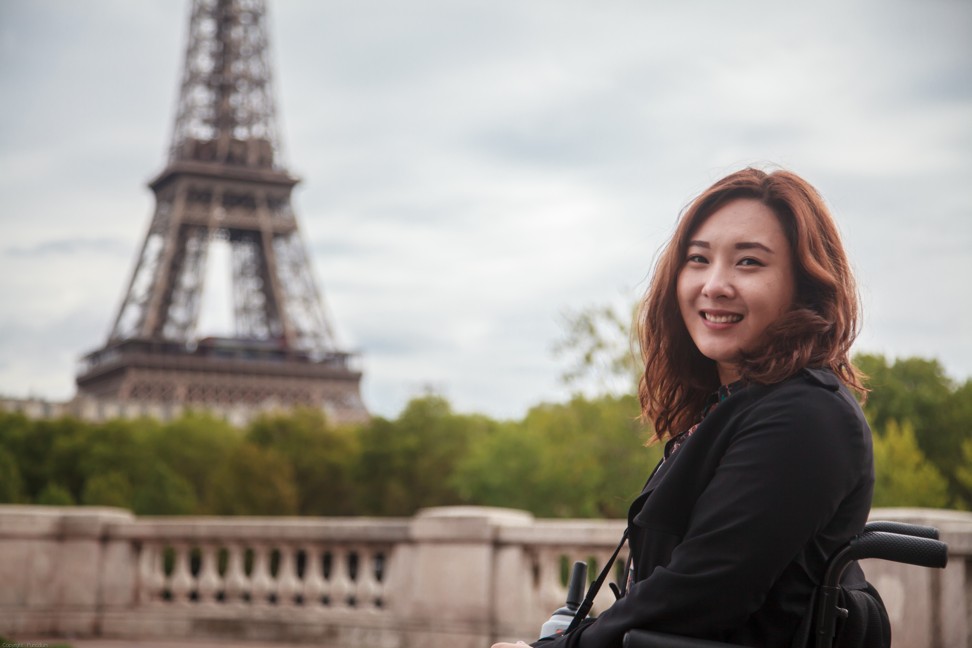
Accessible tourism: disabled Korean globetrotter blazes trail for travellers with disabilities, and Seoul has heard the message
- Hong Seo-yoon is founder of Accessible Korea, a non-profit group focused on improving access and facilities for disabled visitors to her country
- She has travelled the world in a wheelchair and wants others to be able to do the same
Hong Seo-yoon manoeuvres through shifting clusters of picture-snapping tourists outside Deoksugung, a palace in downtown Seoul. Before passing through the former royal residence’s wooden gate, she adjusts her motorised wheelchair’s speed ahead of a gradual incline in the stone walkway that leads to a tree-lined courtyard.
Even small modifications, such as replacing a step with sloping pavement, gives people like Hong access to places that otherwise would have been difficult or impossible to enter independently, she says.
Hong, 32, says able-bodied people are often unaware that when it comes to tourism, sightseeing or even extreme sports, many disabled people, whether they are blind, deaf or use a wheelchair, all want the same things as other travellers.
“They want to travel, they want to visit places. I don’t think there’s a difference,” she says. “Having a disability is not something special or weird.”

Hong is the founder of Tourism for All Korea, a non-profit organisation that advocates for greater inclusion in the tourism industry for people with a disability and makes policy recommendations for improvements in this sector. She is also author of Europe, there’s no reason not to go, the first travelogue written by a wheelchair user from her country.
Her work has informed Seoul’s efforts to make its streets, public transport and tourism sites more accessible for disabled citizens and visitors.

Since 2017 the South Korean capital has installed more than 9,000 “convenience” features, including lifts, handicapped toilet stalls and raised or tactile paving for people with low vision, according to the Seoul Metropolitan Government. Earlier this year, the city opened the Danurim Centre, an office that provides information on accessible tourism and transport for both domestic and international travellers.
“Our ultimate goal is to make Seoul a universal city anyone can fully enjoy without any inconvenience,” says Bang Hye-min, a manager at the Seoul Tourism Organisation. Hong’s input was instrumental in the creation of the programme, Bang says. These improvements coincide with a shift towards greater inclusion and equality for people with disabilities that has only come about since the early 2000s, says Hong.
“A generation ago, a person with a physical or intellectual difference might have been a shame to their family,” she says, theorising this attitude was a consequence of South Korea’s post-war trauma, which made economic growth and competition paramount.

Her own experience facing physical and social obstacles underlie her advocacy. When Hong was 10 years old, she suffered a spinal-cord injury during a swimming pool accident that paralysed her from the waist down.
“At that time Korea wasn’t accessible at all for wheelchair users,” says Hong.
She recalls her brother pushing her alongside cars in the street, since the streets in her provincial hometown had no pavements. Hong says she also faced discrimination when her parents were told to send her to a distant institution for disabled people because there wasn’t a lift in the local, four-storey middle school.
Instead, her family moved to the Philippines, where a nurturing teacher told Hong that having a disability was not abnormal.

By the time she returned to South Korea to attend university, Hong had learned to stand up for her rights. She got a taste for activism when the university’s administration refused to relocate a class on an upper floor so that she could attend it, telling her she would have to take it another time. Hong fought back and won: the class was moved to the ground floor.
International travel started off as a pastime and over the years became her passion. Now Hong says she has visited more than 30 countries.
But she still faces resistance. Her travelogue idea was rejected by two publishers. “They told me that no one would read about disability stories,” she says. “It really hurt me.”

After promising to buy any unsold copies, Hong convinced the publisher Saenggak Bi Haeng in 2016 to take a chance with her manuscript. She did not have to live up to her end of the deal: all 3,000 copies sold out and it is now in its second print run.
Hong says some wheelchair users send her messages asking how they can do the same activities as she did during her world travels, such as paragliding in Switzerland.
“They never thought that a disabled person could do that kind of sport,” she says. She tells them they do not have to go all the way to Europe to try accessible paragliding: that too is now available in Korea.

